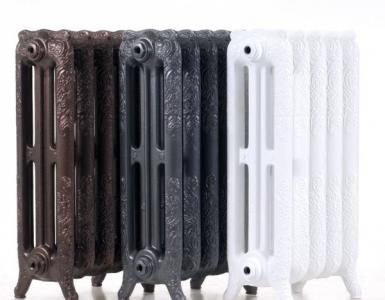How to build a well in the country with their own hands. Video - Wells in the country with their own hands. Recommendations for the arrangement of the upper part of the structure.
Let's try to build a well with our own hands and then your site will have a permanent source of clean drinking water. How to properly and competently dig, and then equip the well? We will now talk about this.
If you think that the digging of wells with your own hands can be made at any time of the year, then you are very mistaken. If you decide to do this in the spring, when snow melts and the groundwater table is at its maximum, there is a high probability that in the summer the water in your well will be gone. Water will go to the lower layers. therefore best time for the construction of a well shaft is autumn and winter - at this time the aquifer is as low as possible.
Before you start digging the well yourself, you need to know about the depth of occurrence in the groundwater section, as well as the nature of the rocks that separate the aquifer from the surface. If neighbors also have wells, then it's easiest to get this information from them. If no one has got a well or you are developing new lands, you will have to drill an exploratory well to find an aquifer, which is a costly and laborious method, but it is the most accurate.
In addition to the depth of the aquifer, for independent digging of the well, the composition of the soil is important. If this sandy soil - wonderful, digging it will be the easiest, clay lends itself more difficult, if in the earth many large stones, then problems can arise, up to the rejection of the entire event.
Which well is better: shaft or tubular?
Wells come in two types - Mine and tubular. Each of these types is good in its own way, however, if we decided to dig a well with our own hands, it is important for us to know which of these options is easier to build on our own. Since we have to work only on our own, it is better to choose mine well. It is wide enough and deep, but it will not be difficult to dig it with a shovel - it will be where to turn. It is this structure that looks like most people imagine a traditional well.
well and tubular type - this is another matter. Remember once very popular in countryside "Column" - this is a tubular well. It is installed where the aquifer is close to the ground, it has a small diameter, and a pump is used to pump water into it.
A tubular well is made much quicker and easier than a mine, however, in order to drill a well, special equipment is needed. And we decided to do only with our own hands and shovel, so this option does not suit us.
We will dig a mine well!
Before you build a well with your own hands, you need to deal with it constructive features. So, the constituent elements of the well are:
How to dig a well with your own hands?
After that, continue to dig the bottom of the shaft, gradually exposing the rings on top, which will gradually sink lower and lower. This is done until the aquifer is discovered. The rings are placed one on top of each other, but in order to prevent a possible shift in different directions, they are additionally fastened with metal clips. Digging wells with your own hands is not a slow business, therefore, before you dig down to the aquifer, it will take at least 4-5 days. Variant with gradual settling concrete rings is the most secure.
It is possible to do the same in another way: first to dig completely the shaft of the well, and then to lower it inside the ring. However, in this case, there is a high probability of collapse of the ground on the one who will be inside the mine. And this is fraught with dangerous consequences, so it's better not to take risks!
Installing the bottom filter
Construction of the above-ground part of the well
It is important to pay close attention to the construction of the braces. This is an important constructive element, since in the course of operation (on average this happens 3-4 years later), a well roof can have a little story. In this case the screws with which the braces are fastened are untwisted, and with the help of the level everything is set up anew. The well must also be equipped with a strong lid with a lock. It will close the mouth of the well and protect water from getting there dust, dirt, rodents, and also ensure the safety of children and pets. The gate, which serves to lift the bucket with water, is made from a log about 1.2 m in length and at least 200 mm in diameter. In the absence of logs, it is possible to produce a gate made of timber with a cross section of 200x200 mm. To do this, a circle of any material (for example, a plate) with a diameter of 200 mm is applied from both sides of the bar, it is wound with a pencil and the excess corners are cut with the help of a plane. Further in the center of each end of the gate drill holes of about 10-12 cm in depth in order to insert the axes and the handle of the gate there. Metal parts of the gate, most likely, have to be ordered in the workshop, as they are not sold in stores. Also it is worth to buy 5 washers, of which two are installed on the construction of the gate, and three - on the racks. From the side of the handle the gate is put by two washers, and the third by the other side. The washers will prevent the gate from moving and contribute long service all well construction.
Now, having all the necessary knowledge, you can easily build a well on your site that will serve faithfully and truthfully not only to you, but also to your children, and, possibly, to your grandchildren.
Together with fire and wheel, the well is the greatest invention of mankind. Since the first mine was dug for drinking water, thousands of years have passed, but there are still many who want to use this useful structure. To make good well at the dacha you will need quite accessible tools and materials. We suggest you to understand all the wisdoms of this difficult matter - we literally hold your hand through all the stages.
The well is a fairly wide mine, which should reach the groundwater table. The walls of this mine must be isolated so that the water remains clean. You can use as a liner:
- monolithic concrete;
- concrete rings;
- concrete plates;
- brick;
- natural stone;
- tree.
At the bottom of the well, a special bottom filter is placed, which usually consists of layers of rubble and pebbles. On top of the structure is equipped with a head. The upper part of the well can be framed by a collar, lid, rope, bucket, etc. Of course, water from modern wells is most often obtained by pump.
Please note that tubular and shaft wells are distinguished, however, for the construction of the first option, complex drilling equipment is necessary, so it is possible to make a well in the dacha with your own hands only by the mine method.
The rules for choosing the right place for a well
Experts strongly do not recommend using people's signs to find a suitable place for a well. Hydrological maps and a knowledgeable hydrological engineer will cope with this task much more successfully. It is possible to determine the place for a well mine with the help of neighbors. If there is already a number nearby ready-made well, you can focus on its location and characteristics.
Pay attention is also on the already existing on the site facilities. A cesspool or a septic tank, a bathhouse, places for keeping livestock and poultry, as well as other potential sources of groundwater pollution should be removed from the well by 30 meters or more. Such a source of pollution can become large water objects: rivers, ponds, lakes, etc. Do not dig a well on the shore, the water in it will still be dirty.
What kind of soil do you have - dense or light?
It makes no sense to pay for the services of a specialized brigade if the site owners are able to cope with the task themselves. First of all, you should pay attention to the condition of the soil. On dense soils, the works are performed as follows:
- You need to choose a place for a well.
- Carry out the marking of the shaft, which can be a round or square configuration.
- Dig out the mine.
- Isolate the soil with suitable material.
- Drain the water.
- Backfill the bottom filter.
- To decorate the upper part of the well.
The walls of the mine on dense soils are practically not crumbled, however, light soils are not so stable. In this case, it is best to use the walls of the shaft. For this, a relatively shallow round pit is excavated, into which a concrete ring is immediately installed. Excavations continue from the inside, in the process the ring will fall under its own weight, while protecting the walls of the shaft from shedding. It is recommended to first remove the soil in the center, and then along the edges.

The walls of the well shaft on dense ground do not need additional reinforcement. On light soils, the probability of land collapse is high, so the walls are immediately reinforced with concrete rings
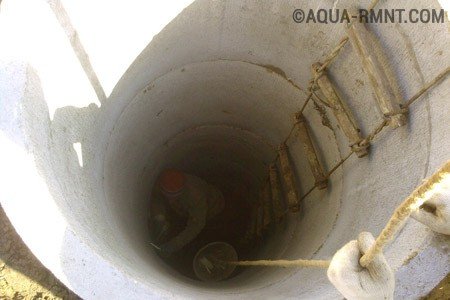
When working on the installation of a well in the country, a number of safety rules should be followed: wear a protective helmet, check the strength of the cables regularly, and so on.
Concrete rings are a very common material for a well mine, and they are also successfully used on dense soils. In this case, digging is recommended from the edge of the ring to the center. Joints of concrete rings should be carefully sealed. Perfectly copes with this task tarred hemp rope.
Features of the well mine
If the ground condition allows, different materials can be used for the well shaft. In this case, it is necessary to regularly apply a plumb bob so that the shaft is vertical, and also to monitor the correct size of the shaft.
Option # 1 - solid concrete
To make a continuous concreting of the well, it is necessary to install a wooden formwork in the shaft and fill it concrete mortar. After that, the formwork is removed, and the space between the ground and concrete is covered with a mixture of sand and gravel.
If a deep well is concretered, an upsetting method is applied. The well is concreted within the permissible limits, and then the monolithic concrete is deposited to the required depth. At the same time, in the lower part of the shaft, you need to make a special shoe equipped with a knife.
Option # 2 - concrete plates
Elements weighing about 35 kg are suitable for wells of rectangular configuration. They are bound with a solution. To reinforce the corners of the structure, you will need to conduct welding work.
Option # 3 - brick
To carry out the shaft of the well, one should take a well-burnt red brick of high density. Clutch is performed in a circle. It must be ensured that the walls of the shaft are perfectly vertical.
Option # 4 - natural stone
Limestone, sandstone or slate are great for a well. Like brick, the stone is laid in a circle, fastened with a moderate layer of mortar. In wells, the stone should not protrude into the shaft or outward.
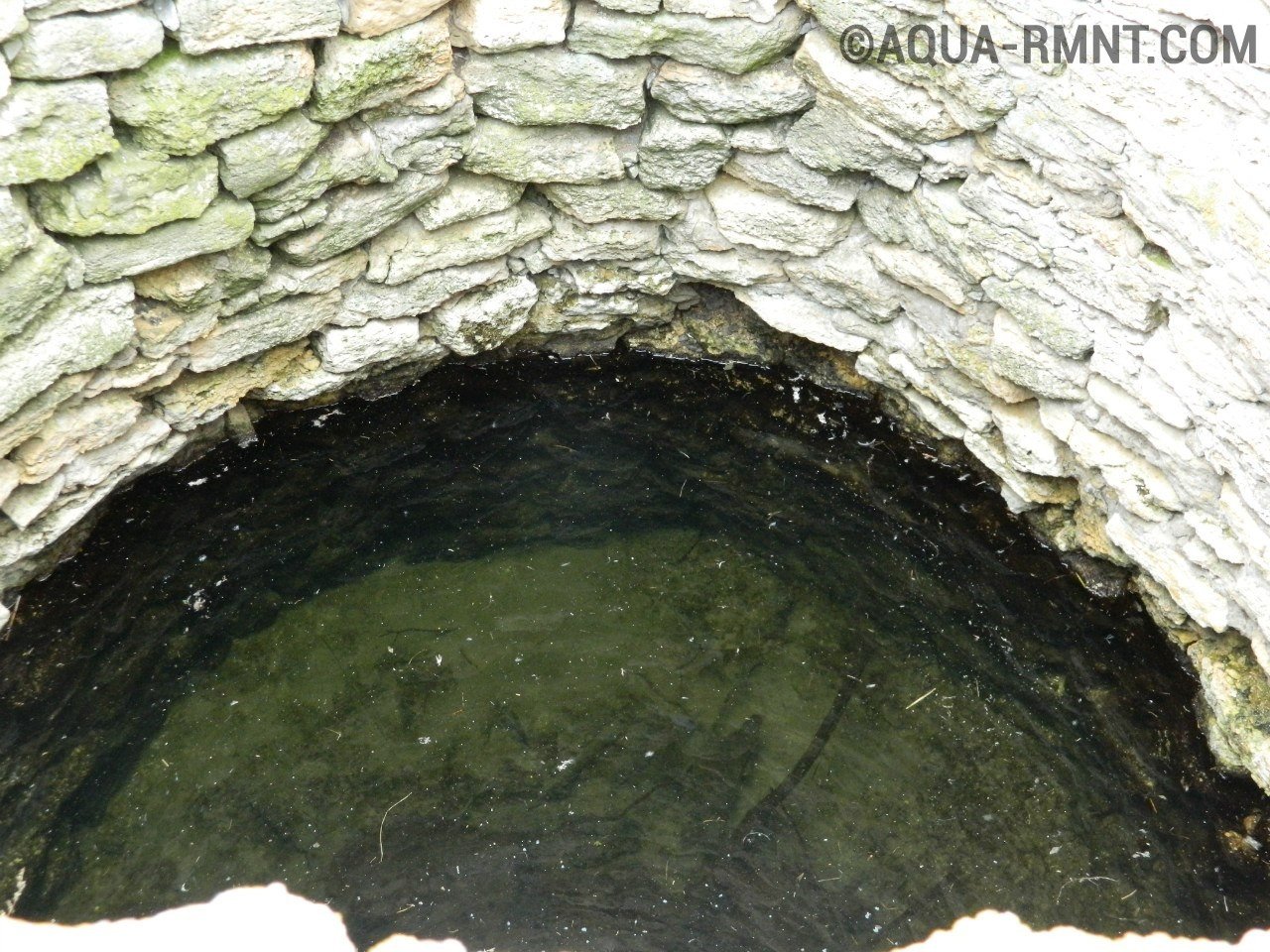
The well, made of natural stone, will last a long time and will look great in the natural landscape. For masonry it is recommended to use stones of approximately the same size
Another important point - the narrow end of the stone should be directed to the center of the mine. This position is considered more resistant to ground pressure on the masonry, the probability of squeezing out individual elements decreases. Before starting work, it is recommended to sort the stone by the size. The best quality is considered to be masonry from stones of the same size.
Option # 5 - wooden frame
The tree is perfect for decorating a rectangular well pit. A small block for a well of shallow depth can be collected, starting directly from the bottom of the well. The crowns are placed on top of each other and pressed with strong punches. Seams between crowns should be smeared with clay. On weak soils under the lower crown of the log, it is recommended to lay a number of large stones.
With a large depth of the structure (more than 40 m), the log is assembled separately, then the pit is installed for the mine and gradually increased to the required dimensions while simultaneously selecting the soil. The edges of the lower crown should be sharpened to facilitate lowering the structure. Sometimes for this purpose special steel knives are mounted on the frame. To avoid skewing the frame in the process, undermine the four crowns.
The most difficult is the technology of building a large log from below. It is necessary to make a series of rims with a "finger". Then they are pressed against the main crown with the help of a jack.
Pumping out water and filling the bottom filter
After the mine is ready, dirty and muddy water accumulates below. It must be pumped out with a good mud pump. You can use a bucket, but it will be too long and tedious. Bucket choose the accumulated at the bottom of the silt and mule. Then you need to wait about 12 hours and pump out the accumulated dirty water. This procedure is repeated daily until the appearance of clean water at the bottom of the well.
After that, the water is pumped out once more and starts. First, the bottom of the well is covered with a layer of clean river sand. Then, three layers of crushed stone are covered with a thickness of about 10-20 cm each. On the bottom you can put a layer of rubble of large fractions, then - the middle layer and a layer of small gravel. Thus, a so-called direct bottom filter is obtained. Crushed stone can also be stacked in the reverse order: small, then medium and large. This is how the reverse bottom filter is made.
After filling the rubble, the incoming water can still remain cloudy. It may be necessary to pump the water out several more times. It takes about two weeks for the final post-treatment of water. During this period it is not recommended to use well water for drinking or cooking, but for technical needs it is quite suitable. Before starting the full-fledged use of a new well, you should select a sample of drinking water and give it for analysis.
How to properly arrange the headings?
Mounting the head is the last but very important part of the well construction at the dacha. After the space between the mine and the ground is covered with a mixture of sand and gravel, it is necessary to make a clay lock on top. It will protect well water from possible contamination.
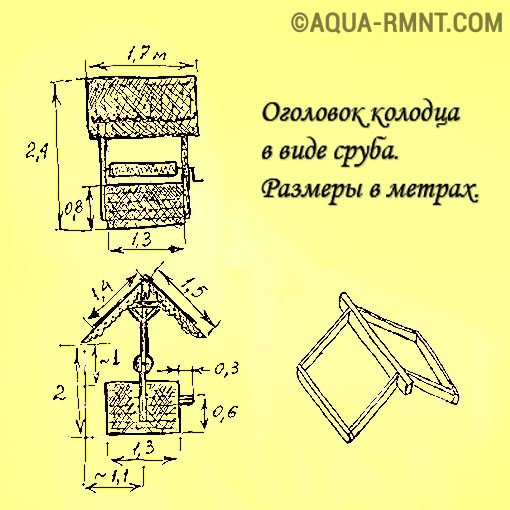
A beautiful and comfortable head of the well at the dacha can be made from a wooden beam. It looks like a frame, covered with a roof, fixed to the pillars
Sometimes a shaft of a well is made level with the ground and simply closed with a lid. Such a utilitarian variant is not common. Usually owners of dachas try to decorate the well, constructing small houses, enclosing the structure, etc. Modern wells, especially in the country, it makes sense to decorate with such traditional devices as a gate, cable or chain and a clean bucket of galvanized steel. If the pump fails for some reason, the house will not be left without water.
On sale you can find ready houses for the design of the well, which you just need to install. You can make this structure yourself, using a wooden beam. From it you need to make a simple frame, the basis for which serve on concrete blocks. You will need waterproofing works. On top of the crook make a comfortable ledge, on which you can put a bucket. Concrete block blocks are recommended to be installed on a layer of sand about 10 cm thick to prevent deformation of the structure due to seasonal soil displacements.
The frame is closed with a lid, and a roof is installed from above to protect the well from precipitation. The roof can be made from a double row of planks laid with overlapping so that there are no cracks. The easiest way is to make the roof of the well from a sheet of metal. The roof is mounted on supporting poles with spicules. Due to the load, the structure will gradually deform, periodically (every few years) it is recommended to correct the position of the braces.
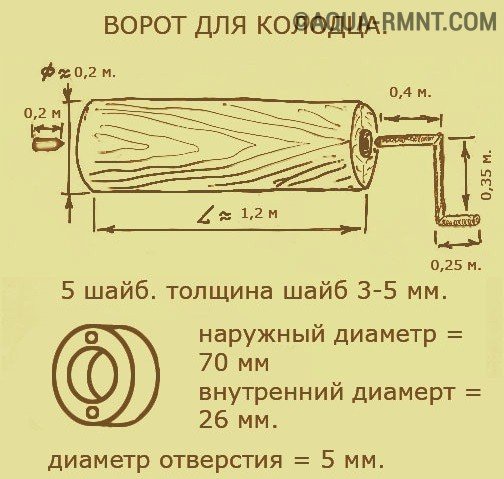
The gate for the well in the dacha is made from a piece of logs of a suitable diameter. As fasteners, five metal washers are used
To produce the gate, you need a log length of about 1.2 m and a diameter of about 20 cm. By circulating or patterned at the ends of a log, a circle of appropriate dimensions is drawn and then the gate is wrought with a planer or an ax to smooth and smooth. Then in the center of the ends you need to make two holes with a diameter of 22 mm and a depth of about 120 mm. To fit the gate was strong, the diameter of the axis of the gate should be 2 mm larger than the holes, ie 24 mm.
After this you will need to put washers:
- two washers on the gate itself;
- two washers on the rack, which will have the handle of the gate;
- one washer on the counter opposite the handle.
The washers will help secure the door in the correct position. In the center of the log cabin is attached a cable or chain, to which a bucket is suspended. The site around the log house also makes sense to decorate with suitable materials: paving slab, stone, wooden flooring, etc. An originally designed well will become a real decoration of the dacha landscape.
Own water source on your beloved suburban area will significantly increase the level of comfort. Eliminate the need for buckets to carry water to care for the treasured plants, to fill the tanks in the bath or shower. The construction of a water intake structure can be entrusted to a team of workers specializing in this field. But it is better to dig and equip a well in the dacha with your own hands, investing in it a minimum of funds.
Any enterprise requires from the future performer a thorough pre-training. All the more so laborious as digging a well.
Errors in planning, distribution of forces and working stages will necessarily affect the outcome. In the best case, the construction will last for a long, but not known, term, at worst - will end with the device of a useless tunnel "to nowhere."
Image Gallery

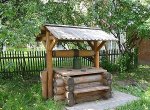


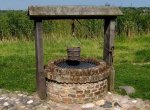

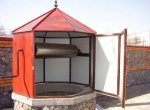
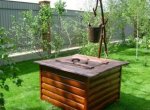
Research of an independent hydrogeologist
In order to exclude the meaningless costs of funds and muscular efforts, it is necessary to conduct preliminary hydrogeological studies. The best option Exploration - drilling, but to perform it on their own before building a well is at least unreasonable, and hiring drillers is expensive and unprofitable. It is better then immediately water intake well to drill.
Independent hydrogeological surveys consist of a banal survey of neighbors who have their own well or well. Find out from them you need:
- At what depth is the mirror of the water in the high water and in the droughty period.
- How many meters have been drilled or excavated for the installation of water intake facilities.
- Does not the property "leave" water from the water intake, if summer is not pleased with the precipitation of two / three weeks, but exhausts with heat.
- Which soil was extracted from the wellbore or well during their development: it was clayey or sandy.
- It was not necessary for the drillers to break a boulder or builders of a well to lift a large heavy stone from a well.
Traditionally, suburban land allotments and suburban areas are located in a flat area without pronounced relief structures. Wells are digging into sedimentary deposits that are easy to develop. Work is carried out to the first aquifer, trying to pass and close the vadose, if it is located at a depth of about 3-4 m from the surface.
Most of the country cottages are located in the flat terrain, for which the horizontal occurrence of the ground layers is characteristic. Groundwater in the flat areas is almost at the same level
Underground water, containing pores of sedimentary rocks, usually lies in the form of a kind of basin. According to the gravitational prescriptions and the law of communicating vessels, the surface of this basin is practically at one depth at all points. This means that the geological and hydrogeological situation on your site will be almost the same as that of a neighbor.
Some deviations in the level are fixed in the course of groundwater movement. For example, if it is unloaded in the form of a spring in the ravine located 3-5 km from the site of work. Then the level in the point closer to the spring will be somewhat lower than in the far analog. However, these deviations can be neglected in the well of the well; their meaning is usually unimportant.
A significant difference in the height of the groundwater level (groundwater level) will be if the well is placed on a hillside. Water will always drain to the side of easy discharge, which the slope provides to it. Therefore, on such sites they try not to build wells, since Natural drainage significantly reduces the amount of water produced.
If there is a perch in the area, the level of which in the spring-autumn period will be 3-4 m on average, it is recommended to cover it with the trunk of the well and reach the underlying aquifer. The level and water content of the perch are unstable, the water is most often contaminated by domestic sewage
By neighboring sources, you can determine the depth of the mirror with a fairly high accuracy, using a barometer. Its scale is marked by divisions with a price of 0.1 mm, which translates to a height of 1 m. So if the device shows 831.7 mm above the neighbor's output, and the point of the planned well is 831.5 mm, then the depth of your water intake the construction will be 2 m more.
Information on the composition of soils will help evaluate your own strengths for self-digging. If neighbors are assured of the complexity of development and the availability of a large number of boulders, it is better to delegate work to the shabashniki team. They still have to follow their actions, which means that the technologies for building a well need to be read.
The approximate water level in the well planned for construction can be determined from the mirror of the nearby reservoir. The water in the well will be approximately at the same elevations
In addition to the "testimony" of owners of existing water intake facilities, organizations that conducted drilling or construction near your site can provide information on the hydrogeological conditions of the area. The information can be provided by a local meteorological service, which has a complete package of data on climatic conditions, natural phenomena and geological situation in the region.
How to identify a place for digging a well
For a water intake facility, it is necessary to choose a suitable place in advance. It is undesirable to arrange it there, where garden plants were planted for several decades and fertilized the earth with chemical compounds. Note that well water is rarely drunk. If the plans do not include extraction of the drinking category, then the previous cycles of fertilizer application can be ignored.
Due to the small size of the suburban areas, it is difficult to find a place for a well drinking water. Due to the insufficient distance from the possible pollutants of groundwater to the source, it can only be used for cleaning and watering (+)
Let's list the main factors of influence on the selection of a site for the construction of a well:
- Pollution elimination. Remoteness from the places of possible entry of negative components: from household and household buildings, pens for cattle, cesspools, compost heaps of not less than 20 m. In the case of a well with drinking water in a suburban area, there should not be any such objects at all.
- Reduce costs. The shortest possible maximum pipeline route, if a water supply system is to be installed. The smaller the length of the trunk, the less money will be spent.
- Optimal location. Between the foundation of the cottage and the well should be at least 5 m. Water intake structure will "draw in" the groundwater in accordance with the principle of whirlpool. He will constantly strive to replenish the dredged reserves, attracting not only water, but also soil particles, which will eventually scrape the soil under the foundation when the well is in close proximity.
Vast dacha for our realities is rare, because choosing a place in the direction of groundwater movement on the site is strange, at least. However, if the earth's surface of the allotment has a certain slope, then it is best to choose a place under the well at the lowest point, if possible. There, and the thickness of the soil to be extracted, will be smaller, and the flow of water is greater.
According to the requirements of SanPiN under the number 2.1.4.544-96 between the source of drinking water and the objects of probable contamination of groundwater (cesspits, compost piles, cattle pens, etc.) should be at least 50 m
Specificity of well design
The maximum depth of a traditional well with a shaft-trunk is 30 m. It is dangerous to dig lower, too heavy, it is impractical for costs and labor. At the dacha you can make a very shallow well, the height of the mine will be 6 - 8 m.
Dig a shallow shaft is easy, to extract water, a standard bucket or inexpensive surface pump. However, the extracted water of shallow workings is applicable only in irrigation and other economic purposes.
Water intake can be made with a mine of 15 - 20 m. From such a depth, it is more likely to get water coming to drink. The chances are especially high if the aquifer is covered by loam or sandy loam - clayey rocks that do not allow water to pass through. They prevent the penetration of atmospheric and flood waters together with domestic sewage, technical oils, chemicals.
The task of the builder of the well is not only to extract the soil from the mine, but also to form the walls of the well mine. They are built of stone, bricks, logs, wood plates, timber, monolithic reinforced concrete, embedded in the formwork in the pit. The most common variant of material for wall construction at the moment is factory concrete rings or self-made analogues, filled in the form directly on the site of works.
Regardless of the material used to construct the walls of the shaft, its design includes three main elements: 1 - water intake, 2 - barrel, head (+)
Regardless of the material used to construct the walls of the well, they are constructed in accordance with a single constructive scheme. Its main parts are:
- Headline. Part of the mine, towering above the earth's surface. The standard height is 0.7 - 0.8 m, but with variations. It is equipped with a well house for protection against atmospheric negativity. For manual lifting water is equipped with a collar or a crane.
- Trunk. Part of the mine, measured from the mark of the earth's surface to the water's mirror. It serves to strengthen the walls of the mine and to protect it from soil collapses.
- Water intake part. A section of the mine submerged in the aquifer. The main working element of the well, providing the supply of water to the structure, if necessary, creating its stock.
In addition to geometric parameters, there are no significant differences in the device of the head and trunk. Different is the width with height, but the shape of the mine in terms of: square or round. The main constructive difference, which determines the division of wells into species, is set by the principle of the device of the water intake part.
By differences in the device of the water intake part, the wells are divided into:
- Imperfect. The water receiving part of this type is immersed in the water-saturated layer by approximately 70% of the water-carrier capacity. The shaft is not installed on the water retainer, so the flow of water into it occurs both through the bottom and through the walls of the water intake part.
- Perfect. The water intake is completely buried in the aquifer. The base of the shaft rests on the waterproof layer, because of which the inflow of water is carried out exclusively through the side walls.
- Perfect with a sump. The water intake part rests on the waterproof layer, water enters the shaft laterally through the walls. The reservoir is supplemented by a kind of reservoir formed in the underlying water-bearing waterproof layer.
Sumpf is arranged to form a reserve of water. Therefore, its volume is calculated based on the actual daily flow rate. If necessary, to increase the volume of water that can be pumped at a time, the sump is arranged in the form of a bell with an extension to the base.
The construction of the well is selected in accordance with the geological situation in the area of work, the experience of neighbors in the construction of similar sources and the real need for water in future owners
In a reasonable choice of the optimal well design, a survey of neighbors can also help. You may be approached by a similar imperfect or augmented by a sump perfect scheme. It all depends on the real need for water.
It should be remembered that well water can not be "stagnated" in the mine. In the case of a long stay there, it will bloom or become rot. If you do not plan permanent residence in the country with a copious reception of water procedures, then an adequate amount of water will give an imperfect design. At the bottom, it is arranged with a bottom filter made of gravel or crushed rock to support grains of sand.
Construction of a well of concrete rings
The construction of the water source in the villa area is the simplest option available for independent execution. The use of ready-made rings will allow you to excavate an excellent well at the dacha with the least loss of power and expense, and if desired, decorate the headland with a stone or a log. However, the most economical will still be a method that presupposes the independent pouring of concrete well elements.
Image Gallery



Technology of construction from finished rings
In the construction of wells from concrete rings, the lowering method is mainly used. Although you can go another way: install concrete elements in a previously dug mine, but the down method is more practical and safe. With it, the walls of the shaft are strengthened simultaneously with the extraction of soil, which excludes the collapse of loose rocks into the trunk during operation.
For the construction of the well, both concrete and reinforced concrete rings with a chamfer facings at the end edge are suitable. Note that for equal sizes, the first and second versions differ in mass. For example, for a concrete ring size of Ø 1 m, a height of 0.7 m, the weight will be 800 kg on average. A similar reinforced concrete element will weigh only about 500 kg.
The use of reinforced concrete factory rings is the simplest method and convenient material for the construction of a pit
In addition, the thickness of the walls of the concrete ring for the construction of the well should be no less than 10 cm, preferably 12 cm. And when using rings of reinforced concrete, a minimum of 6 cm is allowed, but an average thickness of 7-8 cm.
The size of the walls is largely reflected in the size of the internal diameter, and it in turn affects the convenience during the development of the mine and the subsequent use of the well.
The construction of a well of concrete rings does not require the mandatory use of lifting equipment
The wellbore is better to be built in a lowered way, but it is possible to install them in a previously excavated pit using the technology depicted in the diagram
A suitable diameter of the rings is selected with a reference to the comfortable position of the worker during the digging in the shaft. On average, it is from 1.0 m to a maximum of 1.5 m. It is not to be hoped that there will be more water in the wide well. If it is imperfect, then the influx will be equivalent to both a wide and narrow barrel.
In addition to the factory concrete rings, you also need to buy a shoe - a shortened concrete ring equipped with a tool along the bottom edge. It will accelerate the penetration and ensure a smooth immersion of the column of concrete elements in the ground. When the mine is constructed from self-made rings, the lower edge of the starting line is made in the form of a cone.
To significantly simplify the process of lifting the soil from the shaft of the well, a tripod with a hook block attached to its top will help. Descent and lifting can be done using a manual gate or electric winch
If loose soil was extracted from the well of the neighbor well, then there is a chance of clamping the upper part of the trunk with a collapsed rock. At the same time, the lower part continues to descend, the upper part remains clamped in place, and a gap appears between them, which is extremely difficult to eliminate. In order to avoid such a serious accident, it is better to stock up a 16 mm rod for making stapling rings of staples or a strip with a thickness of 5-10 mm.
To facilitate the procedure of lifting the soil from the mine, it is desirable to make a tripod and attach a block to its top. So it is more convenient and faster to proceed with the liberation of the trunk from the abandoned rock.
A stepped version of the shaft well assembly is made of tapered rings that form outside the stiffeners from the outside, from the inside of the step for lifting / lowering
The most common method of constructing a well from the rings is a descending method, according to which the trunk is built from above, and is submerged into the ground by digging in from below
Concrete or reinforced concrete elements for the construction of a well shaft are pre-purchased taking into account the height of a mine of neighbors or are poured on the construction site
Steps of the lowering method of constructing an imperfect shaft:
- We mark the outline of the mine by the actual dimensions of the rings. The simplest method of marking is to install a peg at the center with a string attached to it, equal to half the diameter of the ring. With this simplified compass it is necessary to delineate the boundaries.
- Tear out the circular foundation pit according to the layout. It can be a little wider than the outline, so it's easier to immerse the starter ring. We dig about ¾ of the height of the concrete element.
- We install a shoe with a cutter in the pit, check its position with a level. If necessary, align the position, so that there is no further distortion of the trunk.
- We load the starting ring into the shaft. We fasten it to the shoe in four places with staples or metal plates cut from the strip, if there is no certainty that the shoe does not separate from the concrete column when immersed.
- We choose the soil inside the mine, not digging it under the shoe.
- We dig under the shoe four or more cavities so that they can fit equal in height logs, bricks or similar temporary supports.
- We install the supports so that the assembled part of the well leans on them. We control the landing of the trunk level and plumb line, in order not to correct later the flaws that increase with depth.
- Underpass the remaining areas under the shoe and knock out the temporary supports.
- We put the ring in the ground, trying to observe the uniformity of immersion.
- We operate in accordance with the algorithm described above, while the upper edge of the ring does not align with the day surface.
- We lay along the chamfer of the installed ring the sealant - tarred hemp cord Ø 20 mm. Sealant is used for at least three to five lower rings. It is needed in the water intake and slightly higher in case of a rise in the level during the flood period.
- Set the next ring, if necessary, connect it with the previous one in 3 - 4 places along the circumference.
In this way, we deepen and build up the rings until water-saturated sand appears. We deepen into it as many meters of the mine as was the neighbors'. At this time, it will be necessary to continuously pump the water out of the mine so that it does not interfere with the worker.
The diagram shows the process of digging up the soil under the cutting shoe of the wellbore in steps
If there is no information on penetration into the aquifer, then after installing at least one concrete element, another simplified exploration should be done. Before digging the ground under the trunk, you need to dig in the center of something like a pit. If there are only sand and small stones in the pit, the mine development can be continued until the next ring is immersed.
Then reconnaissance is carried out until the roof of the waterproof layer - clay, clay-like rock - appears on the bottom of the pit. This is the signal to stop digging. Now work in the mine is only in the device of the bottom filter from a three-layer gravel backfill. Gravel is covered in three layers with a thickness of 15 - 20 cm. The fraction of each top layer should be larger than the lower one.
To exclude the displacement and displacement of concrete rings, they are joined by curved staples from reinforcing bars, welded staples or metal overlays with bolted fasteners (+)
At the device on a summer residence of the perfect type of a well, the shaft should be installed on the roof of the waterproof layer. Exploration, of course, to conduct during the period of digging is not necessary. The shaft is just gradually immersed until it is taut in the waterproof.
It should be borne in mind that one or more of the starting links of a perfect well must pass water through the walls. To do this, in the staggered rings, similarities are formed of windows filled with a fine mesh, cinder blocks or similar porous materials with filtering abilities. The number of rings must be such that it completely covers and slightly exceeds the capacity of the water-carrier.
Rings with side filters are used not only in the construction of perfect wells, but also in the construction of imperfect structures in beds with a weak inflow of water.
In order to increase the inflow of water into imperfect wells with a small production rate and to arrange the filtering water intake part of the perfect well, the starting ring is arranged with perforation. Its function can perform unique "windows" of large-pored concrete or holes filled with shallow mesh made of stainless steel
Method of the device from self-made rings
Construction technology is similar to the previous method, but is complicated by the procedure for manufacturing concrete rings. To do this, it is necessary in advance to stock up the dismountable formwork from the planks or sheet metal connected to each other. It is clear that the formwork should be a pair: one part is obliged to repeat the outer surface of the ring, the second is internal. The size and shape of the formwork is better to choose according to the dimensions of the factory rings.
Image Gallery
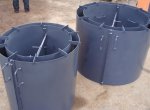
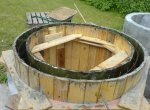
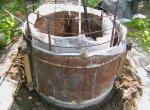
To prepare the solution, portland cement of not less than 400 grade, river or quarry sand and gravel fractions of 30 to 70 will be required. In order for the rings to freely sink into the ground, the walls of the hand-made product should be as smooth as possible. Therefore, preference is given to gravel of fine fractions.
Water is needed with neutral acidity. Its volume is determined from the graphs of the CC, taking into account that the water-cement ratio for pouring the elements of the well can not be less than 0.7. Considering the consumption of cement with water, it is possible to calculate the volume of the initial components for the manufacture of rings.
For the hand-making of the rings, a formwork design must be developed. The optimum proportions of the concrete mixture are 1: 2.5: 4 and / or 1: 2: 3; VC from 0,5 to 0,7
Adhesion of elements of a concrete trunk will be carried out faster and with greater accuracy, if, when pouring, provide a facet chamfer
If it is supposed to install concrete rings in the pit with the use of construction equipment, the reinforcement frame should be laid with mounting loops
It is necessary to think in advance of the type of the seam edge of the rings: the straight is a butt quarter or with a bevelled wall. To form the fold in the pouring period, two more ring-shaped parts will be required, one of which must be laid on the bottom of the formwork, the second one on top of the pouring. These parts must be combined so that the manufactured elements of the well can be tightly connected.
At the stage of preparing the formwork a decision is made to use the reinforcement. If the reinforcing skeleton is applied, the consumption of the grouting solution will be reduced. It is possible that the cost of the ring will increase somewhat, but at the same time the rigidity and strength of the structure will increase.
The armature is constructed from vertically mounted rods and horizontally arranged rings of rod 10 - 12 mm. The diameter of the rings should be smaller than the size of the outer part of the formwork assembly, but more internal, so that the structure can fit freely into the gap formed by them.
Between the vertical elements of the reinforcing cage should be of the order of 25 cm, between the horizontal rings of 10 -20 cm. To create a single system, the reinforcing bars and rings are held together by a binding wire.
Formwork is filled with layers of 100-150 mm in thickness. As the mortar is filled, the mortar is rammed until the cement milks come out on the surface. The grinding should be carried out necessarily, the denser the mortar is laid, the higher the strength characteristics of the product.
After placing the mixture in the formwork, care should be taken to ensure that it is properly cured. The first 10 days of the ring should be protected from possible freezing and drying. The surface should be periodically wetted or covered with wet sawdust.
The starting ring is made with the lower cutting edge. If you do not want to bother with the edge device, you can buy or pour a shoe separately. The formation of filtering windows in the walls of concrete rings, as in the previous case, depends on the constructive type of the well. The technology of constructing a mine from self-made rings does not differ at all.
The bottom of a well of imperfect type should be equipped with a bottom filter. It is covered with three layers of rocks with good filtration properties. The first layer is about 10 cm from the sand, then 15 cm each of small and upper gravel (+)
Having completed the work on the construction of a well mine, it is possible to proceed safely to the arrangement of its own source. At the bottom of an imperfect structure, the trunk of which is buried in a water-carrier, but does not rely on waterproof rock, a bottom filter should be built. Around the trunk, a clay lock should be organized to protect against the ingress of domestic sewage into the mine. The head should be at least equipped with a lid or a canopy and a device for lifting well water.
After completing work on the construction of the mine, it is necessary to equip the wellhead and arrange an earthen lock - a ring of crushed compacted clay. The width of the castle is 0.5 m, its depth is from 1.0 to 1.5 m (+)
Video about building a well with your own hands
Roller with a step-by-step demonstration of the process of the self-made device of the mine shaft:
Building your own well is not an easy, but quite feasible, task that home master can easily solve without attracting hired workers. True, he will need at least two assistants to extract soil to the surface and to monitor the worker's condition at the bottom of the mine. In case of dizziness, it should immediately be raised to the surface, and before work, regularly check the fumes with a burning candle or gas analyzer.
A few superficial signs that the place under the well is chosen correctly:
- Presence of dense, juicy, green grass in the dry period;
- Moss on the surface of the earth;
- Presence of other wells nearby (it is necessary to specify the information about the structure, depth, arrangement of the well with neighbors);
- Near the country plot there is a natural lake or a pond;
- The presence of dense fog in the absence of water reservoirs near the dacha;
- Raising the water level in the basement of the house or in the cellar during floods (melting snow in the spring).
In some regions, a geodetic survey is required to equip one's own well. You should learn about this nuance from local authorities.
All these details must be taken into account when selecting a site and constructing a well at the dacha. After analyzing all the nuances, you can choose a good place for a dacha well.
Well at the cottage of concrete rings
Works on digging a well with their own hands are made only with the use of a special tool that is prepared in advance:

- Two types of shovels (with a short and long handle);
- Several metal buckets for 15 liters (preferably three units);
- The ladder is metal long for the initial digging process;
- Ladder rope for a deeper dive;
- A reliable equipped device for lifting buckets with earth from the depth of the well;
- Pump for pumping water, so that it was possible to equip the water collector;
- Extension piece with lamp or lamp at the end;
- Additional equipment (puncher) for overcoming more difficult obstacles.
Usually, the walls of the well shaft are reinforced with special concrete rings. To equip such wells in the country of concrete rings is best with the use of grooves. They are safer and more convenient to use, they are also easier to mount.
There are two ways of installing concrete rings:
- Mine, deep-submerged;
- Dial-up superficial.
 In the first variant, the shaft - round, with a diameter of 1.25 m, or a square one, 125х125 cm in size - until the appearance of water is pulled out completely. Then the rings are plunged into the well in order. Using the mine method, it is necessary to take into account the high danger of collapse of the ground. Therefore, it can be used, mainly, on a stable soil. In the case of the slightest spillage of the earth layer immediately go to the second method.
In the first variant, the shaft - round, with a diameter of 1.25 m, or a square one, 125х125 cm in size - until the appearance of water is pulled out completely. Then the rings are plunged into the well in order. Using the mine method, it is necessary to take into account the high danger of collapse of the ground. Therefore, it can be used, mainly, on a stable soil. In the case of the slightest spillage of the earth layer immediately go to the second method.
The second way, dial-up superficial, is safer. The concrete ring is installed in a pit, a depth of one meter. Then make a dig for another meter. As a result, the first ring sinks down on its own using the pressure of its weight, making room for the next one. Then put the second ring, undermine, making room for the third. A third ring is installed. Thus, the entire structure is undermined and installed to the required depth.  After the well is excavated, it is necessary to create a filter layer so that a silt ball does not form, which later can stop the renewal of spring water. For this, the bottom of the well is covered with small pebbles or gravel with sand.
After the well is excavated, it is necessary to create a filter layer so that a silt ball does not form, which later can stop the renewal of spring water. For this, the bottom of the well is covered with small pebbles or gravel with sand.
Important to remember! The deeper you fall when digging a well, the less oxygen will become. Therefore, when working at depth, you should use an oxygen mask with a long tube outward.
Well at the cottage made of wood
Despite the tendencies in the development of technologies for the arrangement of the upper part of the wells, the classical tree is not inferior to its leadership, occupying former positions of popularity among summer residents. Widely used materials for the upper part of the well are pine and linden.
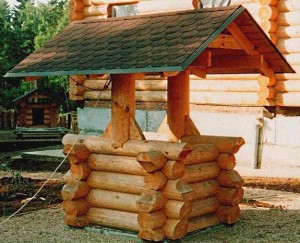 A wooden well at the dacha from the log house is quite expensive. Not every summer resident will be able to afford such wells. In addition, the installation itself is very difficult.
A wooden well at the dacha from the log house is quite expensive. Not every summer resident will be able to afford such wells. In addition, the installation itself is very difficult.
For the construction of a well from a log house, it is first necessary to excavate a pit equal to the average human height.
Then the following work is done on the development of the well:
- At the bottom of the foundation pit formed crowns of larch.
- Prepared log house is collected in order. Slots of joints must be treated with a sealing substance with the use of a pack. This should be done for the lower layers up to 3 m high.
- After laying the first part of the well, you need to dig the ground from under the middle of the beams, the resulting structure.
- When all the earth is cleaned, spacers are installed and the earth is cleaned from the corners of the well.
- After cleaning the well from the ground, you need to fix the safety ropes to the base of the log house in the well. To do this, you can use a winch.
- The spacers are removed, as a result of which the construction begins to dive into its own well under its own weight. If there is any distortion, you can tap the top with a sledge hammer to level the structure.
- Thus, the frame is topped from above and lowered to the bottom. So you can install a log house to a depth of 6 meters. At this level, the construction is jammed by spacers, which are made 50 cm longer. They need to be inserted into the prepared grooves from the bottom.
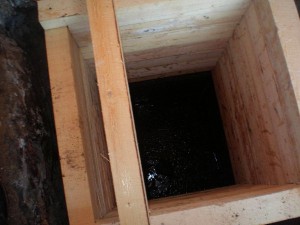 If the well is planned to be made below the 6-meter mark, it is necessary to select the ground before the appearance of the first water. The first signs that the aquifer is close is the increased humidity of the air and the soil itself (it is becoming more saturated with water).
If the well is planned to be made below the 6-meter mark, it is necessary to select the ground before the appearance of the first water. The first signs that the aquifer is close is the increased humidity of the air and the soil itself (it is becoming more saturated with water).
To equip the mine wells, specially processed and prepared wood is used. The construction of such wells does not require additional strengthening elements. The structure of the tree is quite strong and durable. As a material for the beams used solid wood (mainly oak, alder, aspen, elm, hornbeam).
It is highly discouraged to use birch, spruce, and a number of other coniferous trees that have water-absorbing properties for the arrangement of wells. Their use in the future will lead to the appearance of the bitterness of water. They will quickly lose their strength and soon begin to deteriorate.
Wells made of wood at the dacha are an excellent element of the decorative design of the yard, emphasizing the delicate taste of the owner. A wooden well is an excellent protection against ingress of dust, dirt, foreign objects, sewage storm water. To summer residents who have such wells, it should be remembered that from time to time they need to be serviced (treated with a protective layer of waterproofing materials).
Water from the well
The presence of a well in the dacha allows the owner to think about carrying water into the house. The installation of a water pipe is best done together with the installation of the well itself.
To start, you need to build a highway from the well to the house. For this, a trench is digging, at least 80 cm deep, with a spade-wide shovel.
At the bottom of the trench a 7-centimeter cushion of sand is poured out and a pipe is laid (it can be plastic, metal-plastic, metal). Experts recommend laying plastic pipe section 32 mm. After laying the pipe, a 5-centimeter ball of sand is poured, then you can cover the entire trench.
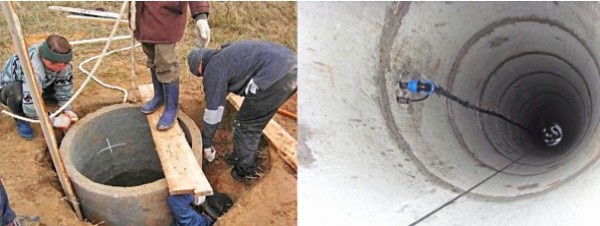
In the ring of the well, a hole is punched, into which a pipe is wound. In the house, a foundation breaks through and a pipe is inserted inside, where it must be connected to. In the well, the pipe joins with another pipe, which reaches the bottom of the well.
As a power unit for supplying water from the well to the dacha, it is possible to apply a submersible deep-water pump, the power of which must be calculated depending on the length of the water main.
Arrangement of a well at the source dacha fresh water - is one of the main elements of life support and comfort of the summer resident. Make a well at the dacha with your own hands is very real, but you should remember about security measures and, in no case, do not neglect them.
How to make a well in the country (video)
Despite the fact that now many garden plots have centralized water supply systems, many of their owners are trying to build a well in the country. It is not only an ornament of the landscape, but also a source of clean drinking water, a reserve fund for household needs. In areas where there is no centralized system, it is often the only source of water. The cost of the well is directly dependent on the depth of the groundwater. If they are close to the surface, then you can set up a dacha well yourself.
Types of wells
The main types of wells:
- Key. If there is a water key on your site, it is not difficult to equip it, ennobling this place. The design of the well and its finish depend on your imagination;
- Abyssinian. In fact, this is a simplified version of the well. Other names: needlepoint, needle. To construct such a well, sandy-macadam or sandy soil is needed. It consists of a "needle" (inch tube with a cone at the end) with a screen filter and check valve. If the depth of groundwater is more than 6 meters, then the pump is installed. Service life 15-20 years;
- Mine. It is quite simple to equip, does not require an expensive pump. The service life is 40-60 years;
- Sewage well - another kind, without which the homeowner can not do.
Parts of a well

The three main parts of any well:
- Headline (that which rises above the surface of the earth);
- The trunk (well shaft);
- The water intake (where there is water).
The head is also called the house of the well. It protects the trunk from pollution and precipitation. It is made of wood, stones, slate, etc.
The trunk can be reinforced concrete, plastic or wooden (moisture resistant logs made of oak, elm, alder, larch wood are used). The trunk does not allow the well to freeze in winter. On the low-water soils in the lower part of the well, a buzzer is arranged - a tank for collecting and storing the water reserve.
Where to dig?
First of all, it is necessary to determine how close to the surface of the earth groundwater on your site. To find out the depth of their occurrence, one can either interrogate neighbors or drill an exploratory well. Start kopka better at the beginning of the autumn period, when the level groundwater the lowest, and it will not interfere with you when you work.
Dig a well in a solid ground, at maximum distance from the toilet, pens with animals, etc., no closer than 5 meters from the base of the house, as close as possible to consumers of water.
Abyssinian well
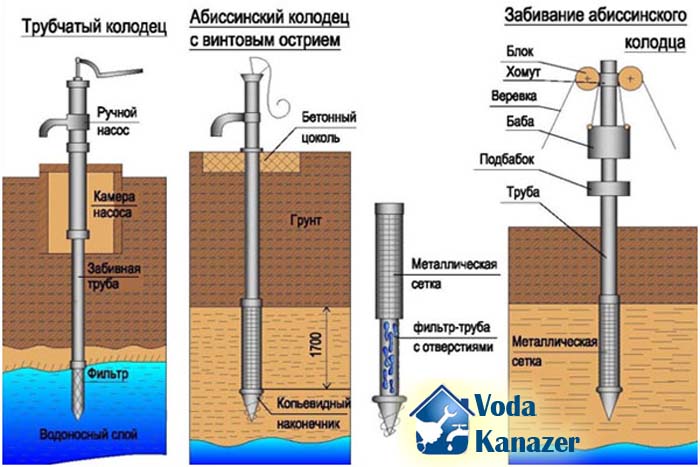
For arrangement abyssinian well You can use purchased ready-made kits, but you can make parts yourself
To do this, you need:
- Stainless pipes with a diameter of 1-1.5 inches;
- Silicone couplings for pipe joints;
- Knitting wire,
- Stainless mesh with small cells;
- Stainless tip;
- Electric pump;
- Cast-iron woman for driving pipes.
We make the filter: on the pipe to which the tip is fastened, the hole is made in a staggered manner by the drill. We wind this place with wire, with a step of 1-2 cm. On it (with the help of screws or rivets) we fix the net. Mount the tip.
Mounting the well is reduced to driving the pipe with the tip to the aquifer.
- First you need to dig a pit with a volume of 1 m 3 for equipping the above-ground part of the well;
- Then we make a groove in the garden drill, where we hammer the first pipe with the tip. With the help of the clutch we screw to it the next pipe, etc. After plugging to the required depth (up to the aquifer), we wash the filter under pressure, lowering the hose into the pipes;
- Install the pump and pump out dirty water;
- Concrete the above-ground part of the needle.
Mine Well
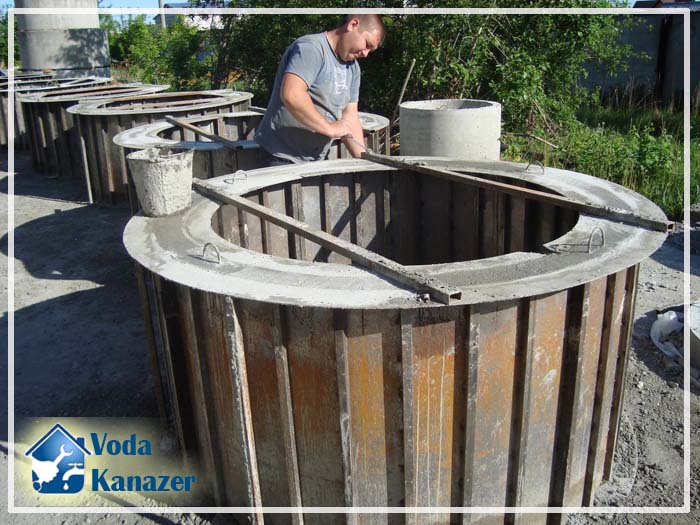
First of all, you need to determine the material of the design. Most often they are made of concrete rings or plastic. Plastic dacha well can be purchased at the store, and reinforced concrete rings can be made by yourself.
Convenient for mounting the dimensions of the rings: a diameter of about 90 cm with a wall thickness of 7 cm and a height of 90 cm.
- We make the formwork. On the leveled surface we lay a sheet of thick plywood wider than the diameter of the future ring by 40-50 cm. From the roofing iron, make two circles for the formwork of the reinforced concrete ring. We fasten them with bolts. Nuts should be located on the outside of the formwork and be greased with a solidol. Using wooden spacers, we mount rings on plywood;
- Preparation and pouring of concrete. Composition of the mixture: cement - 1, sand - 3, crushed stone - 4 parts. For the two lower rings, it is better to take the ratio 1.5-2-4. The solution should be well mixed (it is recommended to use a concrete mixer). First, fill the formwork with a solution to ¼ of the height and we ram it with a bar. Then install the reinforcement ring and 6-8 vertical racks 80-90 cm from the reinforcement 6-8 mm. Fill the solution three-quarters of the height of the formwork and re-install the ring. After the final pouring, we install 5-7 wooden spacers inside the formwork;
- Removing formwork. You can disassemble the formwork in 8-10 days. The ring can be placed on the edge and left for another 20 days for a set of concrete final strength.
Repeat these steps for the remaining rings, their number is determined by the depth of the aquifer.
For the device wells will need:
- buckets with a capacity of 10-30 liters;
- rope or chain for lifting buckets to the ground;
- a trolley for carrying land;
- rope-ladder;
- winch for installation of concrete rings;
- pump for pumping water;
- hoses;
- shovel with a short handle.
Digging a well
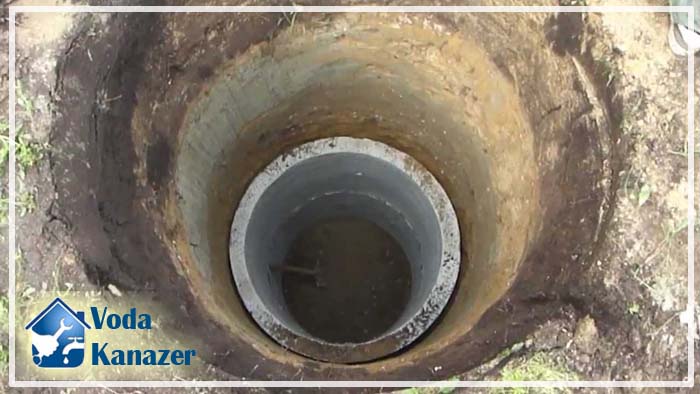
How to dig a well in the country? We excavate the foundation pit, whose diameter is 100-150 cm larger than the diameter of the ring and 10-15 cm deep is less than its height. We lower the ring there. Then we lower the second ring onto it, fasten them with staples and cement mortar. In the excavation we select another 80 cm of soil, then dig the first ring on the outside until the structure sinks to the bottom. We mount the third ring and repeat all operations until we descend to the aquifer. If a well is supposed to go into the house from the well, then one of the rings needs to make a hole for the pipes.
If the reinforced concrete rings have ceased to fall under their own weight, this indicates that you have strayed from the vertical axis of the shaft. To correct the situation, the upper ring is closed with a sheet of plywood and is covered with a large amount of earth and stones. In a few days, the whole construction will shrink, and the digging of the well can be continued.
When the water begins to flow quickly at the bottom of the foundation pit, it must be pumped out and deepened by another half a meter. The last ring should rise above the ground by 40 centimeters. After that, clean the bottom and leave the well for 12 hours to fill with water. At the upper ring in the meantime, you need to make a clay castle.
After lowering the two rings, it is better to mount a mechanism to lift the earth from the pit. On both sides of the excavation we install two tripods and a transverse pipe with a diameter of 50 mm. A pulley is attached to it, through which a chain or rope is transferred with a bucket.
The next day we pour out some dirty water from the well a few times, and arrange a mineral filter on the bottom. For this, we lay well washed layers 10-15 cm high:
- river pebbles;
- small gravel or gravel;
- quartz sand.
Decoration of the well in the suburban area - at this stage it is difficult to give specific recommendations, it all depends on your imagination. You can lay a well with natural stones or make a wooden frame, install a crane, etc. The most important thing is that the shaft of the well is reliably protected from contamination.
Sewage well
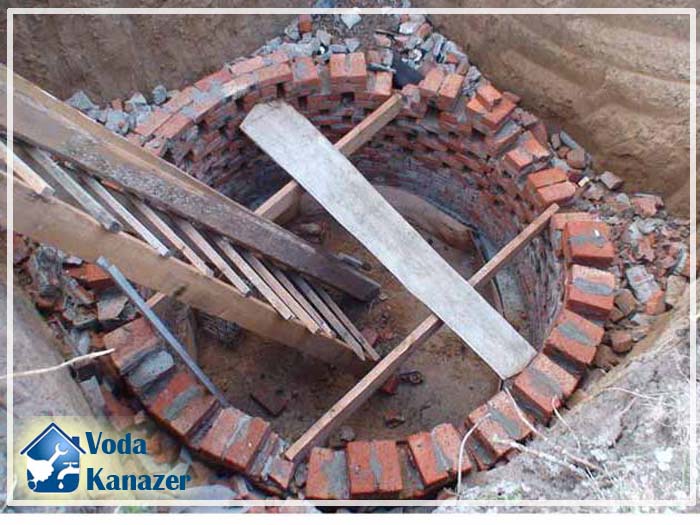
Traditionally it is made of brick, concrete slabs or plastic. To equip such a well in the country with their own hands is easy. First, we determine its place. The sewage machine must be able to access it, and drinking well should be located at a distance of 30 m from it.
Dig a hole of the right size. We fill the bottom with a layer of gravel or gravel about 40 cm high. If it is planned to make the construction leak-proof, then fill the gravel with cement mortar or lay a concrete slab on the bottom. The walls of the foundation pit are covered with slabs, the joints are sealed with cement. Then drain pipes are added. On top of the structure is covered with a concrete slab with a hatch.
Apparently, it is not so difficult to make a well in the dacha with your own hands, as it seems at first glance.




